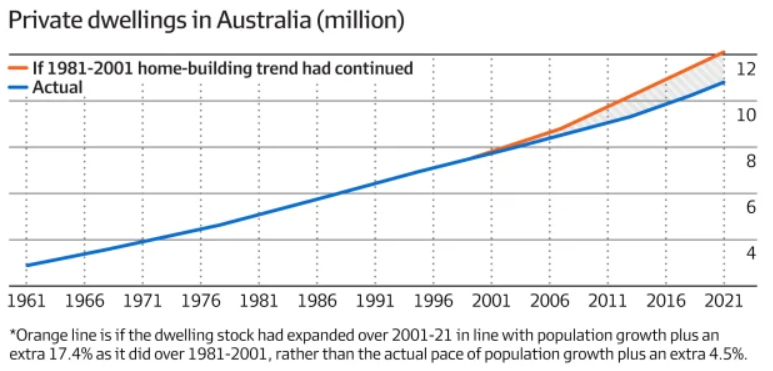The AFR View has taken gaslighting on Australia’s housing shortage to a new level with the following tripe:
“Australia’s housing affordability crisis is due to the supply side, stupid!”
“Dr Richards’ research, published in The Australian Financial Review on Monday, shows that in the 20 years before 2001, the supply of new homes grew by 17% above the rate of population increase”.
“In the following two decades, new home construction slowed to just 4% above population growth”.
“If the relationship between population and housing stock had been maintained, an extra – now “missing” – 1.3 million dwellings would have been built, substantially reducing the housing shortages now being experienced across the country”.
Below is the actual passage from Richards’ article in The AFR:
“For many decades following the Second World War, the percentage growth in the number of homes was well in excess of the growth in the Australian population”.
“At the 1981 census, the total number of private dwellings was 22% higher than would have been implied just by the growth in the population since the 1961 census”.
“In the 20 years to 2001, growth in the number of dwellings was 17% higher”.
“But around the start of this century that changed. In the 20 years to 2021, the percentage growth in the number of dwellings was only slightly faster (by 4.5%) than the growth in the Australian population, and the long-term downward trend in the average household size largely stopped”.

Source: Dr Tony Richards (via The AFR)
“If the relationship between the growth in the population and the housing stock seen in the 20 years to 2001 had been maintained over the 20 years to 2021, Australia would have had around 1.3 million more dwellings than the 10.85 million dwellings reported in the 2021 census”.
“The nation’s housing stock would have grown by around 220,000 dwellings per year over this 20-year period, rather than the growth of 153,000 per year that actually occurred”.
Below is the chart plotting actual dwelling completions against population growth:

As you can see, Australia’s rate of dwelling construction actually surged higher in the 2010s. However, this construction boom was not enough to keep pace with the massive surge in immi9gration-driven population growth from the mid-2000s, which is projected to hit new heights going forward:

In the 20 years to 2001, Australia’s net overseas migration (NOM) averaged 95,000 people a year and population growth averaged 217,000 people a year.
In the 20 years to 2021, Australia’s NOM averaged 182,000 and population growth averaged 320,000 people a year. And this includes the negative NOM experienced over the pandemic.
Why hasn’t Richards or The AFR View taken into account the doubling of NOM in their analysis of housing supply?
The housing supply situation will obviously continue to deteriorate given actual construction levels are falling at the same time as Australia is projected to experience record population growth of between 400,000 and 500,000 people a year, according to the federal budget (see second chart above).
The problem is that Australia has run one of the world’s largest immigration programs, which has ensured that housing demand has forever run ahead of supply – a situation that will only worsen under the Albanese Government’s extreme immigration settings.
If the Albanese Government genuinely cared about ending the nation’s housing shortage, it would run an immigration program significantly lower than the growth of the overall dwelling stock, not the other way around.
It’s time to stop scapegoating a ‘lack of supply’ and speak honestly about the issue.
Australia will never build enough homes so long as its population continues to grow like a science experiment via extreme levels of immigration.
Australia’s housing problem is really an excessive immigration problem.
Anybody that complains about supply without referencing Australia’s extreme immigration is gaslighting.

